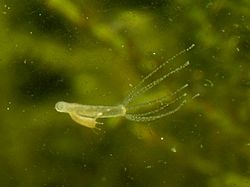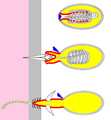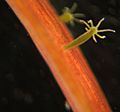Hydra (animal) facts for kids
Quick facts for kids Hydra |
|
|---|---|
 |
|
| Hydra viridis | |
| Scientific classification | |
| Kingdom: | |
| Phylum: | |
| Class: | |
| Order: |
Hydroida
|
| Family: |
Hydridae
|
| Genus: |
Hydra
Linnaeus, 1758
|
Hydra are tiny, simple animals that live in fresh water. They are invertebrates, meaning they do not have a backbone. Their bodies are made of two main layers of cells. Hydra have a special body shape called radial symmetry. This means their body parts are arranged around a central point, like the spokes of a bicycle wheel. They have a central opening that acts as both a mouth to take in food and an exit for waste.
Hydra belong to a group of animals called Cnidaria. This group also includes jellyfish and sea anemones. Like their relatives, Hydra have special stinging cells on their tentacles. These cells help them catch food. Most Hydra are so small that you need a microscope to see them clearly. You can find them in almost any clean body of water, like ponds or lakes.
How Hydra Reproduce
Hydra have an interesting way of making new Hydra, called budding. In budding, a small bump, or "bud," starts to grow on the side of the parent Hydra. This bud slowly gets bigger and develops its own tentacles and mouth. When it is large enough, the new Hydra breaks off from the parent. It then lives on its own.
How Hydra Move
Even though they are tiny, Hydra can move if they need to find new food or a better spot to live. They move by doing a slow, funny motion that looks a bit like a somersault. They attach their tentacles to a surface, then flip their body over, attaching their foot. They keep doing this until they reach where they want to go.
Special Protection
Scientists have found something very cool about Hydra. They produce a special protein called hydramacin. This protein acts like a shield for their outer skin. It protects them from tiny germs and bacteria that could make them sick. It's like their own natural germ-killer!
Images for kids
See also
 In Spanish: Hidra para niños
In Spanish: Hidra para niños



